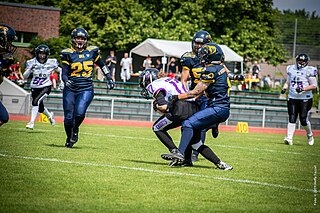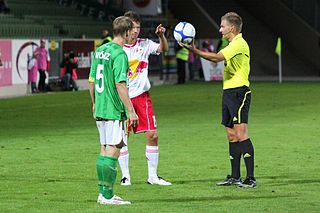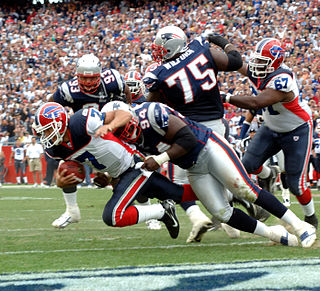
A free kick is an action used in several codes of football to restart play with the kicking of a ball into the field of play.

A free kick is an action used in several codes of football to restart play with the kicking of a ball into the field of play.

In association football, the free kick is a method of restarting the game following an offence by the opposing side.
For more serious offences, such as handball or serious foul play, a direct free kick is awarded, from which a goal may be scored directly against the opposing side. (If such an offence is committed in a team's own penalty area, a penalty kick is awarded instead).
For less serious offences, such as offside, an indirect free kick is awarded, from which the ball must touch another player before a goal is scored. [1]
In American football, after a safety is scored, the ball is put into play by a free kick. The team that was scored upon must kick the ball from their own 20-yard line and can punt, drop kick, or place kick the ball. In professional play, a kicking tee cannot be used – however, a tee can be used in high school or college football. Once the ball has been kicked, it can be caught and advanced by any member of the receiving team, and it can be recovered by the kicking team if the ball travels at least 10 yards and bounces at least once or a player of the receiving team touches the ball. [2] [3] [4]
In Canadian football, after scoring a safety touch, the scoring team has the option of taking control of the ball and beginning play from their own 35-yard line, kicking the ball off from their 35-yard line, or accepting a kickoff from the 25-yard line of the team that conceded the score. [5] If a kickoff is chosen it must be a place kick, and the ball can be held, placed on the ground, or placed on a tee prior to the kick. As in American football, the ball must go at least ten yards before it can be recovered by the kicking team. [6]
Another example occurring in American football is the fair catch kick, a field goal attempted freely from the spot of a fair catch. Although the National Football League (NFL) does not consider the play a free kick, the National Federation of State High School Associations (NFHS) and media analysts regard it as being a free kick. The kick must be either a place kick or a drop kick, and if it passes over the crossbar and between the goalposts of the defensive team's goal, a field goal, worth three points, is scored to the offensive team.
Under NFHS rules, kickoffs are also classified as free kicks. [4]
A free kick in Australian rules football is awarded after a player commits a penalty. The player must then kick the ball back to the other team. When a free kick is awarded, the player's opponent stands the mark, standing on the spot where the umpire indicates that the free kick was paid or mark was taken. The player with the ball then retreats backwards so that the ball can be kicked over the player standing the mark; the player must retreat on the angle such that he, the man on the mark and the centre of the attacking goal are in the same straight line.
A free kick in rugby union is usually awarded to a team for a technical offence committed by the opposing side. Once awarded a free kick, the team must decide how they wish to play it. Options include choosing to play a place kick, drop kick, punt, or take it as a scrum.

Canadian football, or simply football, is a sport in Canada in which two teams of 12 players each compete on a field 110 yards (101 m) long and 65 yards (59 m) wide, attempting to advance a pointed oval-shaped ball into the opposing team's end zone.

A penalty kick is a method of restarting play in association football, in which a player is allowed to take a single shot at the goal while it is defended only by the opposing team's goalkeeper. It is awarded when an offence punishable by a direct free kick is committed by a player in their own penalty area. The shot is taken from the penalty spot, which is 11 m from the goal line and centred between the touch lines.

Gridiron football, also known as North American football, or in North America as simply football, is a family of football team sports primarily played in the United States and Canada. American football, which uses 11 players, is the form played in the United States and the best known form of gridiron football worldwide, while Canadian football, which uses 12 players, predominates in Canada. Other derivative varieties include arena football, flag football and amateur games such as touch and street football. Football is played at professional, collegiate, high school, semi-professional, and amateur levels.
In rugby football, the penalty is the main disciplinary sanction available to the referee to penalise players who commit deliberate infringements. The team who did not commit the infringement are given possession of the ball and may either kick it towards touch, attempt a place kick at goal, or tap the ball with their foot and run it. It is also sometimes used as shorthand for penalty goal.

A corner kick is the method of restarting play in a game of association football when the ball goes out of play over the goal line, without a goal being scored and having last been touched by a member of the defending team. The kick is taken from the corner of the field of play nearest to the place where the ball crossed the goal line.
This is a glossary of terms used in Canadian football. The Glossary of American football article also covers many terms that are also used in the Canadian version of the game.

American and Canadian football are gridiron codes of football that are very similar; both have their origins partly in rugby football, but some key differences exist between the two codes.

Gameplay in American football consists of a series of downs, individual plays of short duration, outside of which the ball is or is not in play. These can be plays from scrimmage – passes, runs, punts or field goal attempts – or free kicks such as kickoffs and fair catch kicks. Substitutions can be made between downs, which allows for a great deal of specialization as coaches choose the players best suited for each particular situation. During a play, each team should have no more than 11 players on the field, and each of them has specific tasks assigned for that specific play.

A goal kick is a method of restarting the play in a game of association football. Its procedure is dictated by Law 16 of the Laws of the Game.

A dropped-ball is a method of restarting play in a game of association football. It is used when play has been stopped due to reasons other than normal gameplay, fouls, or misconduct. The situations requiring a dropped-ball restart are outlined in Law 8 and Law 9 of the Laws of the Game; Law 8 also contains the dropped-ball procedure.

A kickoff is a method of starting a drive in gridiron football. Additionally, it may refer to a kickoff time, the scheduled time of the first kickoff of a game. Typically, a kickoff consists of one team – the "kicking team" – kicking the ball to the opposing team – the "receiving team". The receiving team is then entitled to return the ball, i.e., attempt to advance it towards the kicking team's end zone, until the player with the ball is tackled by the kicking team, goes out of bounds, scores a touchdown, or the play is otherwise ruled dead. Kickoffs take place at the start of each half of play, the beginning of overtime in some overtime formats, and after scoring plays.

In gridiron football, the safety or safety touch is a scoring play that results in two points being awarded to the scoring team. Safeties can be scored in a number of ways, such as when a ball carrier is tackled in his own end zone or when a foul is committed by the offense in its own end zone. After a safety is scored in American football, the ball is kicked off to the team that scored the safety from the 20-yard line; in Canadian football, the scoring team also has the options of taking control of the ball at its own 35-yard line or kicking off the ball, also at its own 35-yard line. The ability of the scoring team to receive the ball through a kickoff differs from the touchdown and field goal, which require the scoring team to kick the ball off to the scored-upon team. Despite being of relatively low point value, safeties can have a significant impact on the result of games, and Brian Burke of Advanced NFL Stats estimated that safeties have a greater abstract value than field goals, despite being worth a point less, due to the field position and reclaimed possession gained off the safety kick.

A comparison of American football and rugby union is possible because of the games' shared origins, despite their dissimilarities.

High school football, also known as prep football, is gridiron football played by high school teams in the United States and Canada. It ranks among the most popular interscholastic sports in both countries, but its popularity is declining, partly due to risk of injury, particularly concussions. According to The Washington Post, between 2009 and 2019, participation in high school football declined by 9.1%. It is the basic level or step of tackle football.

A field goal (FG) is a means of scoring in gridiron football. To score a field goal, the team in possession of the ball must place kick, or drop kick, the ball through the goal, i.e., between the uprights and over the crossbar. The entire ball must pass through the vertical plane of the goal, which is the area above the crossbar and between the uprights or, if above the uprights, between their outside edges. American football requires that a field goal must only come during a play from scrimmage while Canadian football retains open field kicks and thus field goals may be scored at any time from anywhere on the field and by any player. The vast majority of field goals, in both codes, are placekicked. Drop-kicked field goals were common in the early days of gridiron football but are almost never attempted in modern times. A field goal may also be scored through a fair catch kick, but this is also extremely rare. In most leagues, a successful field goal awards three points.
A penalty in rugby union is the main disciplinary sanction available to the referee to penalise a team who commit deliberate infringements. The team who did not commit the infringement are given possession of the ball and they may either kick it towards touch, attempt a place kick at goal, or tap the ball with their foot and run. It is also sometimes used as shorthand for penalty goal.

The laws of Rugby Union are defined by World Rugby and dictate how the game should be played. They are enforced by a referee, generally with the help of two assistant referees.

Futsal began in the 1930s in South America as a version of association football, taking elements of its parent game into an indoor format so players could still play during inclement weather. Over the years, both sports have developed, creating a situation where the two sports share common traits while also hosting various differences.

A free kick is a method of restarting play in association football. It is awarded after an infringement of the laws by the opposing team.